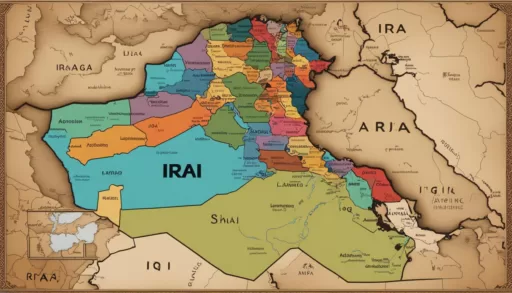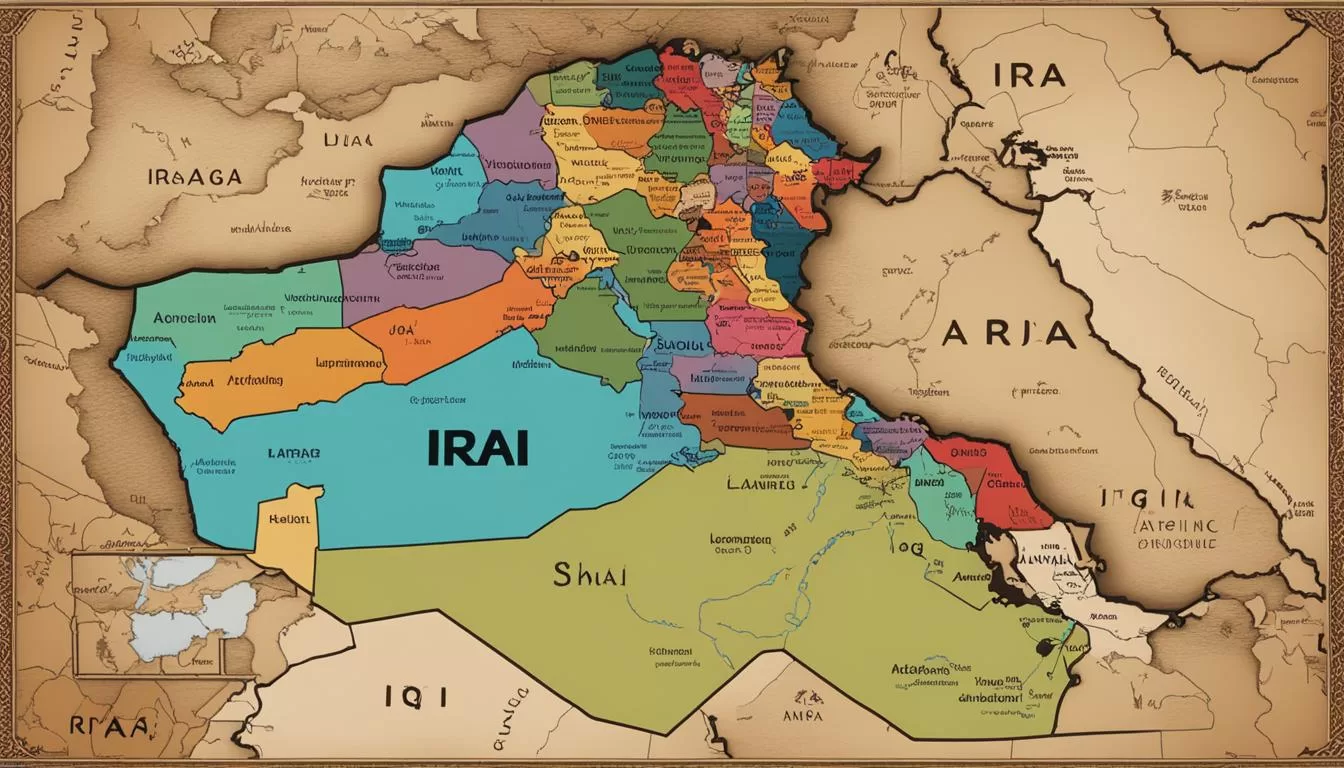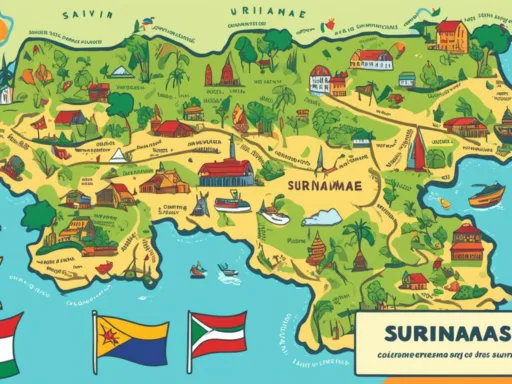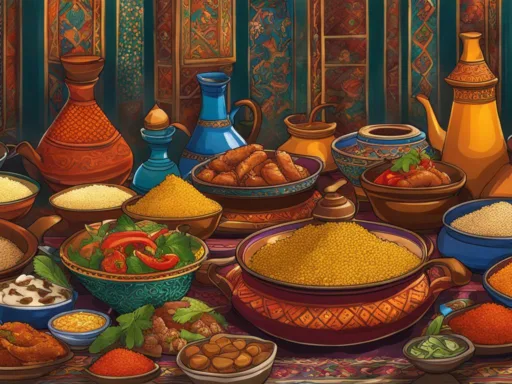The nation of Iraq is as diverse in its languages as it is in its cultural heritage. With a history that stretches back to the cradle of civilization, it’s no wonder that the languages spoken in Iraq tell a story of ancient origins, cultural exchange, and modern-day resilience. Among the Iraqi languages, Mesopotamian Arabic — or Iraqi Arabic — serves as the lingua franca, bridging the communication gap between various ethnic groups across the country.
While Mesopotamian Arabic is widely spoken, the official languages of Iraq also include Kurdish, with its rich array of dialects contributing to the nation’s linguistic diversity. These official languages are not only used in daily interactions but also hold a berth of prestige, being the mediums through which government and official matters are relayed. As we delve into the linguistic matrix of Iraq, we embark on a journey through time and tradition, witnessing the coexistence of multiple dialects and languages that shape the collective identity of its people.
Key Takeaways
- Iraq’s primary language, Mesopotamian Arabic, is a thread woven into the fabric of the nation’s identity.
- The constitutionally recognized official languages of Iraq include both Arabic and Kurdish, each serving its unique role in governance and culture.
- Language in Iraq goes beyond communication, bearing the imprint of historical timelines and civilizational shifts.
- Kurdish language dialects add a layer to Iraq’s linguistic diversity, attesting to the Kurdish population’s significant presence.
- Iraq’s linguistic policies reflect its commitment to embrace – and preserve – the multicultural makeup of the region.
- An understanding of Iraqi languages enhances our appreciation for Iraq’s complex societal fabric.
The Linguistic Tapestry of Iraq
Tracing the contours of Iraq’s complex linguistic landscape reveals a history imbued with the legacy of ancient languages. From the fertile banks of the Tigris and Euphrates, the Sumerian language, one of humanity’s oldest, sprouted, scribing its stories onto clay tablets. Soon after, the Akkadian language took up the scriptorial torch, engraving its cuneiform characters into the annals of history. The echoes of these languages reverberate throughout Iraq, whispering tales of times when their script covered artifacts and edifices.

Moving through the millennia, Aramaic began to permeate the region, capturing the marketplace’s clamor and the temple’s chants. And while its classical form waned, modern iterations of the Aramaic tongue endured, infusing the Neo-Aramaic language with its venerable roots. This linguistic inheritance weaves through the cultural quilt of Iraq, alongside other strands like the intricately patterned threads of the Persian language, the robust weaves of the Turkish language, and the delicate embroideries of the Armenian language.
Historical Influences on Iraqi Language
With Sumerian supplanted by Akkadian around 1700 BCE and Aramaic ascending to dominance from 1200 BCE to 100 CE, each successive language has left a distinct mark on the region’s communicative canvas. The succeeding centuries saw the steady cadence of Aramaic transition to the rhythmic vibrancy of the Neo-Aramaic language, evocative of a historical continuum that spans over two thousand years.
Modern Linguistic Dynamics
In current times, the predominant Mesopotamian Arabic maintains its supremacy, articulated through a modified Perso-Arabic script that vividly illustrates the region’s interconnected saga. Kurdish, holding its acclaimed position as the second most prevalent language, resonates in the dialects of Sorani and strikes visual chords through its Arabic-like alphabet.
The cultural symphony of Iraq further includes the harmonious diversity of the Iraqi Turkmen/Turkoman community, who converse in the Turkish language’s tuneful dialects, their literature scripted in the clear lines of the Turkish alphabet. Not to be overlooked, the melodies of lesser-known but equally significant tongues such as Domari language and Feyli Lurish echo through the country’s central and eastern landscapes, each a testament to the deep enrichment brought about by Iraq’s ethnic variety.
| Ancient Languages of Iraq | Script | Period of Dominance |
|---|---|---|
| Sumerian | Cuneiform | 3300 BCE – 1700 BCE |
| Akkadian | Cuneiform | 2350 BCE – 100 CE |
| Aramaic | Syriac script | 1200 BCE – 100 CE |
| Neo-Aramaic | Syriac script | 100 CE – Present |
The linguistic heritage of Iraq is a testament to the resilience of language and culture in the face of time. As this historical tapestry unfolds, it signifies not only the transmission of ancient wisdom but also the fluid integration of linguistic traditions into the vibrancy of modern Iraqi society.
Unveiling the Official Languages of Iraq

The rich tapestry of Iraq’s culture is deeply interwoven with its linguistic diversity, steeped in the history of civilizations that have flourished upon this land. With the historic adoption of Iraq’s constitution on September 18, 2005, the nation took a definitive step in recognizing and preserving this diversity. Through a referendum held on October 15, 2005, the Arabic language and the Kurdish language were proclaimed as the official languages of Iraq, earmarking them as the standard bearers of Iraqi identity and governance. This landmark decision underlined the country’s commitment to linguistic inclusivity and representation.
The bilingual nature of Iraq’s legislative framework ensures equality between Arabic and Kurdish in all state affairs. The constitutionally enshrined status of these official languages enables their presence in education, judiciary, and public administration, signifying a nation that stands at the confluence of Arab and Kurdish civilizations. Moreover, the legislation empowers individual regions and provinces to adopt additional official languages, in accordance with the will of the local populace, as ratified through democratic referenda.
Beyond the primary official languages of Iraq, the constitution also acknowledges the significance of the country’s vibrant linguistic mosaic by conferring special recognition upon minority languages, including Turkmen, Aramaic, and Armenian. These languages, each a living repository of Iraq’s layered heritage, are also granted protections, ensuring their perpetuation and participation in the cultural dialogue of the nation.
| Language | Status | Use in Governance |
|---|---|---|
| Arabic | Official Language | National and Regional |
| Kurdish | Official Language | National and Regional (Kurdistan) |
| Turkmen | Recognized Minority Language | Limited use in Turkmen-populated areas |
| Aramaic | Recognized Minority Language | Usage primarily in Christian communities |
| Armenian | Recognized Minority Language | Limited use in Armenian communities |
Inextricably linked with the cultural patrimony of Iraq, the Kurdish dialects of Sorani and Kurmanji have been largely acknowledged and integrated into the educational curricula, media, and official documents within the Kurdistan region. The Arabic language, archetypal in its reflection of the Iraqi ethos, serves as the primary conduit for national discourse and international diplomacy, duly noted for its illustrious historical foundation and contemporary relevance.
Conclusively, Iraq’s legislature underscores a nuanced understanding and profound respect for the country’s linguistic heritage. By constitutionally acknowledging the importance of the Arabic language and the Kurdish language as the official languages of Iraq, along with recognizing the melody of its minority tongues, Iraq celebrates the pluralistic essence which characterizes its populace and stands as a testament to human cultural richness.
Languages Spoken in Iraq: A Closer Look
Grasping the vibrant linguistic fabric of Iraq requires an understanding of its two dominant languages: Mesopotamian Arabic and Kurdish. These languages are not only communication tools but also cultural emblems that embody the nation’s multifaceted heritage.
Mesopotamian Arabic: The Language of the Majority
The most widely spoken language among Iraqis, Mesopotamian Arabic, serves as the heart of daily communication and cultural expression. With its two primary dialects, Gelet Mesopotamian Arabic and Qeltu Mesopotamian Arabic, this variant has been sculpted over time by numerous linguistic influences such as Turkish, Aramaic, Persian, and Akkadian. These historical interactions have given Mesopotamian Arabic a distinctive character, setting it apart from other Arabic dialects across the Arab world.
While the majority of Iraq’s populace communicates in these dialects, the language’s reach is extensive, with various local dialects emerging north and south of the Hamrin Mountains, demonstrating its adaptability and regional diversity. This linguistic pluralism within Mesopotamian Arabic reflects the crossroads of cultures and epochs that have shaped present-day Iraq.
Kurdish: Language of the North
In the north of Iraq, the Kurdish language thrives as a symbol of identity and resilience among the Kurdish people. The Kurdish linguistic territory is intricate, featuring main dialects such as Northern Kurdish (Kurmanji), Central Kurdish (Sorani), and Southern Kurdish (Pehlewani). Each of these dialects narrates its own tale of cultural and historical significance within the Kurdish community.
The Sorani dialect, predominant in Iraqi Kurdistan, is taught and upheld as the quintessence of Kurdish linguistic orthodoxy in education. In contrast, Northern Kurdish spreads its linguistic branches not only across Iraq but also among the Kurdish diaspora in neighboring countries. The lesser-known Southern Kurdish also finds its speakers within the Khanaqin district, enriching the Kurdish dialectal milieu. This region’s self-governing status has been instrumental in advocating for and legalizing Kurdish as an official language alongside Arabic, signifying its pivotal role in Iraq’s linguistic identity since 1970.

Iraq’s commitment to preserving these cornerstone languages continues to be a central theme in the country’s pursuit of cultural and linguistic authenticity. Both Mesopotamian Arabic and Kurdish play crucial roles in the grand tapestry that is Iraq’s heritage, each with their distinctive narrative and collective memory woven into the broader story of this ancient land.
Peripheral Linguistic Gems: Minority Languages in Iraq
As we delve deeper into the rich linguistic landscape of Iraq, we uncover a vibrant spectrum of minority languages that contribute significantly to the country’s cultural fabric. Among these are the Assyrian Neo-Aramaic, Turkmen language, Armenian language, and Persian language—each with its unique legacy and contemporary relevance. These languages, along with others in the family of Neo-Aramaic languages, not only offer a window into the past but also continue to enrich Iraq’s modern society.

In the tapestry of Iraq’s linguistic diversity, the Assyrian Neo-Aramaic language stands out as a testament to resilience. Spoken by the Syrian Christian communities in northern Iraq, it carries the torch of the venerable Middle Aramaic heritage. Assyrian Neo-Aramaic is integral to literature, spiritual life within church services, and is ingrained in the educational curriculum of several schools. Its continued use signifies the enduring presence of Aramaic in the region despite the sands of time.
Equally distinct is the voice of the Iraqi Turkmen community, who uphold their heritage through the Turkmen language. In areas like Baghdad and Erbil, where Turkmen populations are significant, the language is a strong marker of identity and cohesion. The Armenian language similarly echoes in the bustling streets of Iraq’s cities—legacy of the Armenian diaspora, adding another layer of linguistic identity to the nation’s array.
Further to this rich medley is the Persian language, often spoken by ethnic Persians residing in Iraq as a reminder of historical and cultural overlaps shared with neighboring Iran. The distinction between borders has done little to diminish the Persian-speaking community’s vibrancy, which remains a vital element in Iraq’s societal mosaic.
The following table illustrates the distribution and characteristics of these treasured languages within Iraq’s modern landscape:
| Language | Community | Key Characteristics | Regions Spoken |
|---|---|---|---|
| Assyrian Neo-Aramaic | Syrian Christians | Ancient Middle Aramaic roots, used in literature and church services | Northern Iraq |
| Turkmen language | Iraqi Turkmen | Marks Turkish identity, significant populations in urban centers | Baghdad, Erbil, and surrounding areas |
| Armenian language | Armenian diaspora | Historical presence, concentrated in cities | Baghdad and other major cities |
| Persian language | Ethnic Persians | Cultural and historical ties with Iran, vibrant community presence | Various regions, especially near Iran-Iraq border |
The debate over preserving and nurturing these minority languages has gained prominence, with the government recognizing the cultural capital they hold. Through a plethora of initiatives, including the inclusion of these languages in the educational system and the proactive promotion of their use in public and cultural spheres, Iraq is putting forth concerted efforts to ensure that the legacy of its minority languages is not just honored, but carried forward for the enrichment of future generations.
Preserving Iraq’s Linguistic Heritage
The commitment to language preservation in Iraq reflects a rich tapestry of linguistic diversity. Rooted within the national identity, the safeguarding of minority languages in Iraq is deeply intertwined with education and policy initiatives. As stewards of this heritage, the Iraqi government, educational institutions, and local communities collaborate to ensure the voices of the past resonate into the future.

Education and Language Preservation
In the realm of public schools and higher education, efforts to bolster language education are crucial. A pivotal aspect of these endeavors is the introduction of the Syriac language into curricula, as Syriac represents the historical vernacular of Iraqi Christians. This incorporation into the public schooling system serves as a form of cultural protection, ensuring that the linguistic legacy of one of Iraq’s oldest communities is not forgotten.
Similarly, Kurdish education is receiving much-needed emphasis. The Kurdish language, an essential part of Iraq’s constitutionally recognized linguistic heritage, is being actively promoted within educational setups. This approach is aimed to impart linguistic proficiency and cultural pride among the younger Kurdish-speaking populations.
Government Initiatives and Language Policy
Recognizing the intrinsic value of linguistic variety, government policy in Iraq actively endorses the rights and preservation of the country’s minority languages. This includes the implementation of laws and measures that not only protect but also encourage the use and proliferation of languages like Syriac-Aramaic within various societal domains.
Resonating with the principles of linguistic rights, the constitution of Iraq underlines the importance of honoring all languages spoken within its borders. It stands as a guiding beacon for government-sponsored programs and encourages citizen engagement in preserving their linguistic heritages. Moreover, the constitutional framework allows for regional languages to ascend to official status, pending public approval via referendums, reflecting a robust foundation for cultural protection.
The synergy between government initiatives and public will has established a sustainable pathway for safeguarding linguistic diversity. The result is a nation where legacy and modernity converse—an Iraq steadfast in its quest to carry forward a multicultural lexicon into the coming eras.
| Language | Preservation Approach | Community Impact | Education Integration |
|---|---|---|---|
| Syriac | Curriculum inclusion, Cultural outreach | Syrian Christian heritage protection | Targeted in Public Schools |
| Kurdish | Cultural festivals, Media promotion | National identity reinforcement | Strong presence in Regional Education |
| Turkmen | Language documentation, Media channels | Enhancement of community bonds | Recognition in local schooling |
| Armenian | Heritage programs, Literary preservation | Diaspora cultural preservation | Limited scope in educational systems |
Conclusion: Celebrating Iraq’s Linguistic Diversity and Cultural Richness
At the heart of Iraq’s identity lies a mosaic of languages that reveal the country’s complex history and its contemporary cultural richness. The linguistic diversity found within its borders—from the official Arabic and Kurdish to an array of minority tongues—contributes to a robust narrative that honors Iraq’s multifaceted heritage. The various languages spoken in Iraq are not mere tools for communication; they are living emblems, each with stories that resonate through generations, shaping Iraq’s national tapestry.
Through language education and proactive government initiatives, Iraq embraces the task of preserving its linguistic treasures. By incorporating languages like Neo-Aramaic into school curricula and promoting Kurdish in cultural festivals and media, Iraq demonstrates its commitment to language education. This diligent approach safeguards linguistic diversity, ensuring the vibrancy of every dialect and the cultural richness they embody. It’s a testament to a nation’s willingness to invest in the future of its heritage and the personal identity of its people.
In summarizing Iraq’s endeavours to nurture its diverse linguistic landscape, it becomes evident that these efforts are more than administrative acts; they are the country’s way of weaving a collective memory and extending its narrative into the future. The mingling of languages spoken in Iraq with the vibrant lives of its citizens marks a proud chapter in the nation’s ongoing story—one of linguistic diversity, cultural richness, and an unwavering spirit that reverberates across the Iraqi populace.
FAQ
What are the official languages of Iraq?
The official languages of Iraq are Arabic and Kurdish. Both languages have equal status in the country’s governmental affairs, as established by the Iraqi Constitution.
How has history influenced the Iraqi language?
Historical influences on the Iraqi language are significant. The region’s linguistic past includes ancient languages such as Sumerian, Akkadian, and Aramaic. Mesopotamian Arabic, now the most widely spoken language, has been shaped over time by these ancient languages as well as by Turkish and Persian influences.
Are there any ancient languages still spoken in Iraq today?
Yes, Neo-Aramaic languages, which have their roots in the ancient Aramaic language, are still spoken today, specifically Assyrian Neo-Aramaic by the country’s Assyrian population.
What are some of the minority languages spoken in Iraq?
Minority languages in Iraq include Turkmen, Armenian, Persian, Assyrian Neo-Aramaic, and various Neo-Aramaic languages. Each of these languages contributes to the rich linguistic tapestry of the nation.
What is Mesopotamian Arabic, and how is it distinct?
Mesopotamian Arabic is the most commonly spoken variant of Arabic in Iraq. It includes two primary dialects, Gelet and Qeltu, and features unique characteristics influenced by Turkish, Persian, and ancient languages.
Can regions in Iraq choose their official languages?
Yes, according to the Iraqi Constitution, regions or provinces have the right to adopt additional official languages if a majority supports this decision in a public referendum.
Is the Kurdish language uniform throughout Iraq?
No, the Kurdish language includes several main dialects, such as Northern Kurdish (Kurmanji), Central Kurdish (Sorani), and Southern Kurdish (Pehlewani), which are spoken in different areas of the Kurdish region.
How is Iraq preserving its linguistic heritage?
Iraq preserves its linguistic heritage through education, by incorporating languages like Syriac and Kurdish into school curricula and through governmental policies and initiatives that aim to protect the linguistic rights and cultural heritage of its diverse population.
Are there educational systems in place for teaching minority languages?
Yes, education systems for teaching minority languages, like Syrian Christian schools teaching Assyrian Neo-Aramaic and public schools offering Kurdish language education, are in place to preserve these cultural languages for future generations.
Does the Iraqi government have policies to support linguistic diversity?
The Iraqi government recognizes the importance of linguistic diversity and has established policies and initiatives to support the protection and preservation of minority languages, as well as to encourage cultural transmission to younger generations.






